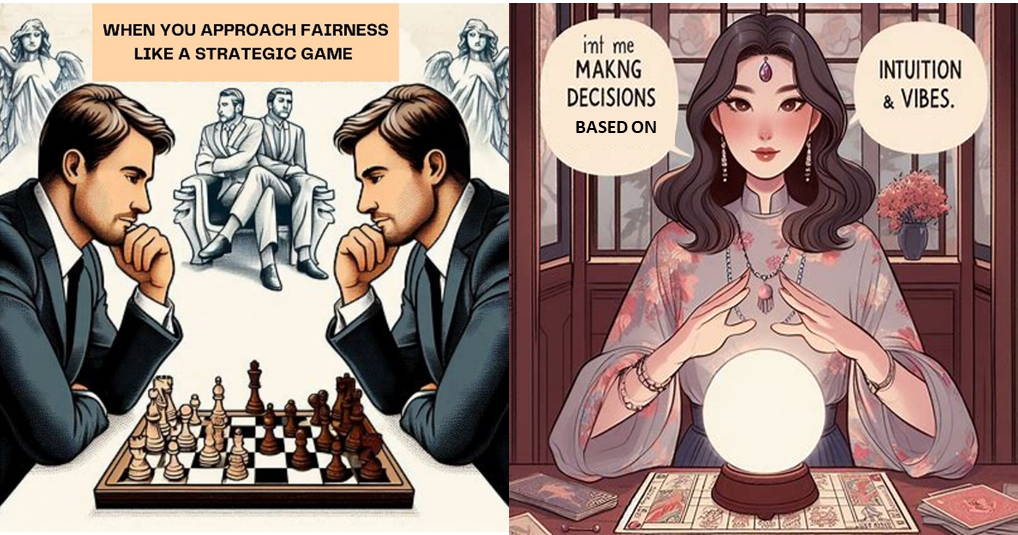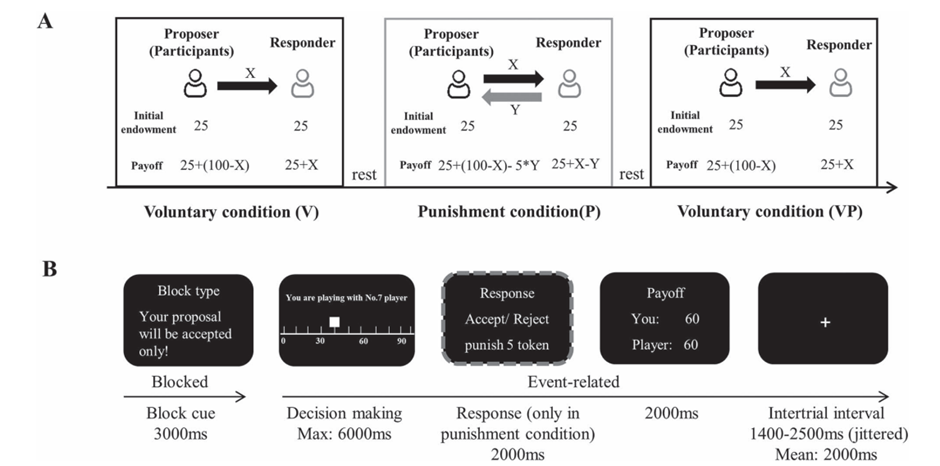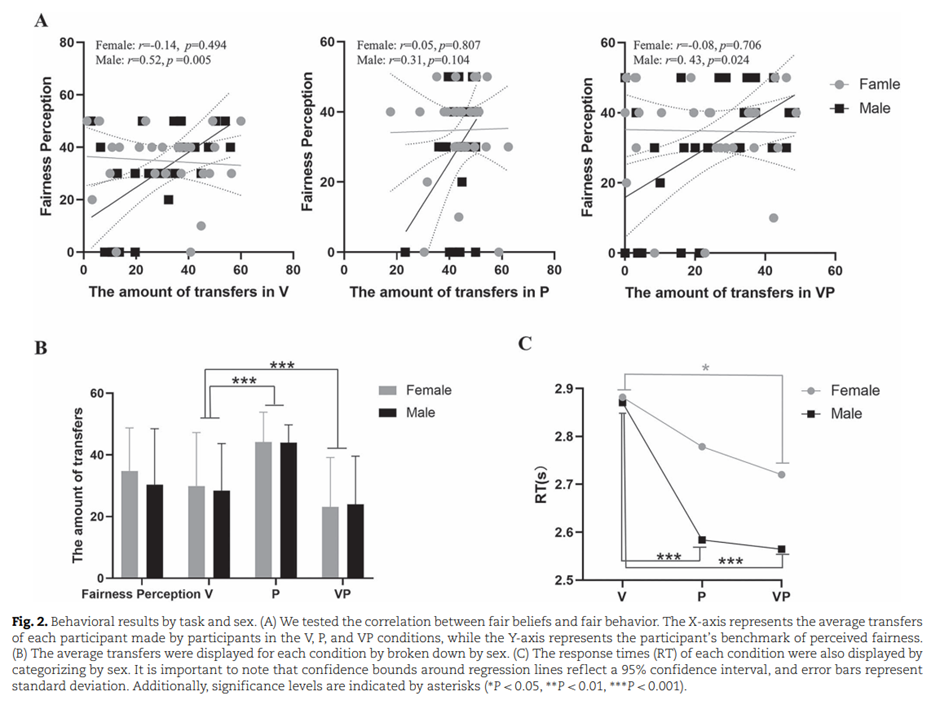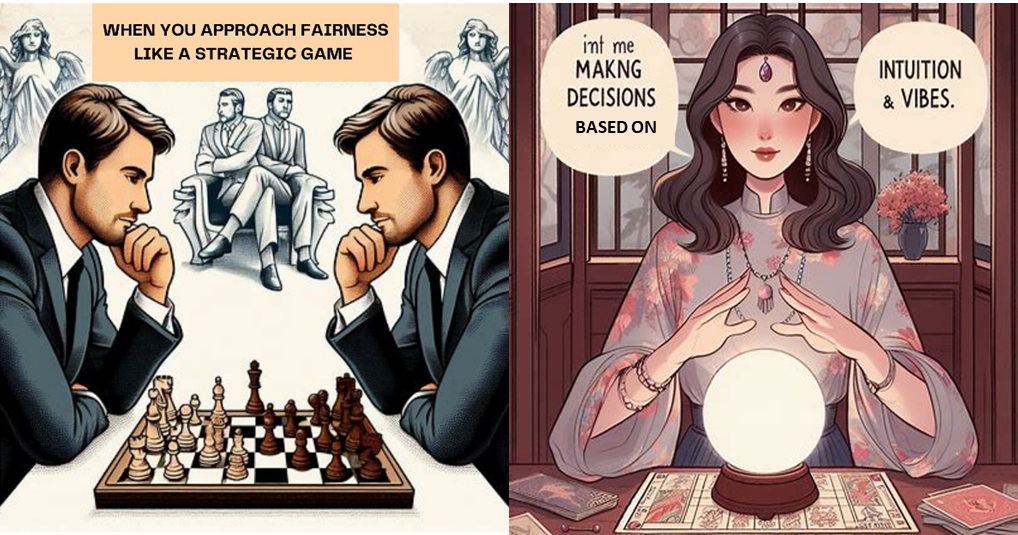By Vasundhara

Source: Bing Create AI
Fairness is in the eye of the beholder – and it seems the beholders have a distinct gender divide – Anonymous
Ever been in a situation where you had to decide how to split a sum of money? Maybe it was a work bonus that needed to be divided among your team, or perhaps you came across some extra cash. Turns out, the battle of the sexes on what’s “fair” runs deep in our brains. A new study has pulled back the curtain on the neural mechanisms that make men and women tick quite differently when it comes to navigating “fairness”.
In a study, it was found that gender differences exist in the willingness to negotiate, with men more inclined to ask for higher compensation compared to women, who tend to hesitate. This raises questions about whether women shy away from asserting their fair compensation. Where does this reluctance stem from? (1)
Similarly, a study published recently found that when it comes to household chores, women still shoulder a disproportionate burden compared to men, even in dual-income families. This imbalance in the division of domestic labor highlights the persistent gender norms that shape our notions of fairness, even in the modern era. (2)
These real-world examples underscore just how deeply rooted gender differences can be when it comes to navigating fairness norms. And now, a groundbreaking new study has shed light on the neural mechanisms that may underlie these disparities. The study by Chen et al. (2024) provides fascinating insights into how men and women differ in their adherence to fairness norms, both voluntarily and especially when faced with the threat of punishment.
The Study:
The researchers recruited 55 healthy adults to participate in a study on fairness-related decision making. Participants played a token game where they had to decide how to split a sum of money between themselves and another player. (Explained in Figure 1)
There were three key conditions in the game:
- Voluntary condition: Participants could freely decide the split
- Punishment condition: If participants didn’t share enough, the other player could choose to punish them by taking away some of their money.
- Voluntary after punishment condition: After experiencing punishment, participants could again freely decide how much to share.
While participants played the game, the researchers used functional magnetic resonance imaging (fMRI) to measure brain activity. This allowed them to see which brain regions were involved in the different fairness decisions.

Fig.1. Experimental design and setup
Key Findings:
- When it comes to divvying up cash in the voluntary round, males tend to stick closer to what they think is fair, while females might not be as tied to their fairness beliefs. It’s like men are more prone to extremes—going all in for themselves or being super generous—compared to women who often strike a balance. Classic!
- Now, let’s talk punishment. When the threat is on the table, both males and females start playing fairer to dodge the consequences. But after punishment, women became significantly less generous compared to before, while men were less affected. What’s up with that? (Figure 2)

The Carrot and the Stick: How Punishments Influence Fairness
So, punishment seems to nudge people to play fairer, which makes sense, right? No one wants to lose their hard-earned cash. (3) This aligns with previous research showing that external pressures, like the fear of punishments, can motivate people to comply with social standards/ norms. And get this, that the brain might act differently in punishment vs. voluntary condition such as that there was increased activity in the parietal cortex in the punishment condition.
However, the study also revealed a potential downside of using punishments – they may undermine intrinsic motivation for fairness. After experiencing punishment, participants became less generous in their voluntary after punishment condition, suggesting that sanctions can crowd out internal moral compulsions. Plus, it’s not just about getting punished—it’s the whole emotional rollercoaster that comes with it. Anger, frustration, you name it. (3)
So, what’s the deal? Sure, punishments can whip us into shape in the short run, but in the long haul, they might mess with our inner sense of fairness. Maybe it’s time for policymakers and bigwigs to rethink their strategies. After all, we want folks to do the right thing because it’s, well, the right thing—not just because they’re scared of getting punished, right? Let’s keep it fair and square out there!

Source: Sheldon tries to blow up Patrick’s head – Coub – The Biggest Video Meme Platform
Men: The Strategist Sharks
When it comes to fairness, men often approach the game with their thinking caps on. In the voluntary condition, moves match up with what they think is fair, showing they’ve got their strategy game on point. Interestingly, neural imaging revealed, stronger activity in brain regions involved in social cognition and self-related processes between rDLPFC-rdAI (between right dorsolateral pre-frontal cortex and right dorsal anterior insula). This suggests men may require more neural processing to behave fairly (meaning that this doesn’t come naturally to them! Whoa!)
However, the plot thickens when punishment enters the equation. Under threat of punishments, men exhibit even greater compliance with fairness norms, accompanied by decreased response times and greater activation in brain regions associated with conflict monitoring and strategic adaptation of decision-making. It’s like they’re masters at reading the room and adjusting their moves for maximum gain. Talk about playing the game! (3)

Source: ⋆ on X: “I may not react but trust me i saw it https://t.co/2a2xLUB9SS” / X (twitter.com)
Women: The Intuitives
In contrast, women bring a different flavor to the table. Sure, on the surface, they might seem similar to guys in the voluntary condition, neural imaging tells a different story. Women show less reliance on strategic calculations and more on gut feelings when it comes to fairness, as evidenced by their neural activity. Females showed a negative representation of rDLPFC-rdAI connectivity, suggesting that they may have an easier path towards reaching voluntary fairness decisions, possibly due to internalized fairness norms. Which makes me wonder that the cultural expectations and gender stereotypes are so deeply ingrained that this comes so naturally to women!!
And when punishment is on the horizon, females’ brains kick into overdrive. It’s like they activate their “empathy hub” (the left middle temporal cortex) and their “self-reflection zone” (the left posterior cingulate cortex). These brain regions are like superhero headquarters for understanding others’ feelings and reflecting on their own thoughts. It’s as if they were channelling their inner superheroes, balancing their own interests with those of others to find the fairest possible solution. Probably that is why they take time for making the decision.
On the contrary, women showed increased activity in temporal and insular regions in the voluntary post- punishment condition, indicating they may be integrating more information to guide their decisions instead of relying on intuition. This nuanced response suggests a shift from spontaneous to obligatory cooperative behaviour indicating a complex decision-making process shown by them.
So, here’s the scoop: ladies lean towards intuition when it comes to fairness, while guys prefer to strategize. But when the heat’s on, both genders step up their game. Guys prioritize fairness under pressure, while gals take a more thoughtful approach. And it all boils down to a little brain region called the rDLPFC—mess with that, and you could shake up fairness for everyone. Who knew brains could be so fascinating, right?
Ok so? What could be the implications for us?
But let’s not overlook the practical implications of our discoveries. These findings aren’t just fodder for academic debates; they hold tangible promise for shaping our world in meaningful ways.
In the realm of law and order, understanding how gender influences perceptions of fairness can guide the development of more equitable legal practices. From sentencing to dispute resolution, policymakers can use this knowledge to craft systems that are sensitive to the diverse perspectives of all individuals, ensuring justice truly is blind.
And in the bustling corridors of corporate culture, where glass ceilings still loom large, these insights can drive change from the ground up. By recognizing and addressing gender differences in fairness perceptions, businesses can foster environments where every voice is heard, every contribution valued and equal pay is promoted.
But let’s not stop there. The ripple effects of our discoveries extend far beyond the confines of courtrooms and cubicles. In our schools, our communities, our homes, we have the power to rewrite the script on fairness.
Fairness, after all, is not a one-size-fits-all proposition. The road ahead may be long, but with each step forward, we inch closer to a world where fairness isn’t just an ideal to strive for, but a reality to embrace.
References:
1) Bowles, H. R., Babcock, L., & Lai, L. (2007). Social incentives for gender differences in the propensity to initiate negotiations: Sometimes it does hurt to ask. Organizational Behavior and human decision Processes, 103(1), 84-103.
2) Bianchi, S. M., Sayer, L. C., Milkie, M. A., & Robinson, J. P. (2012). Housework: Who Did, Does or Will Do It, and How Much Does It Matter?. Social forces, 91(1), 55-63.
3) Cited Article: Chen, W., Xiao, Z., Turel, O., Zhang, S., & He, Q. (2024). Sex-based differences in fairness norm compliance and neural circuitry. Cerebral Cortex, 34(2), bhae052. https://doi.org/10.1093/cercor/bhae052
